算法导论参考答案
- 格式:pdf
- 大小:462.42 KB
- 文档页数:52
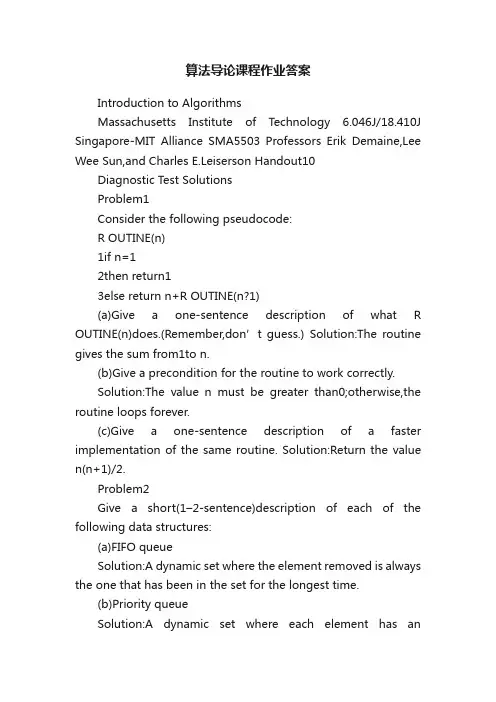
算法导论课程作业答案Introduction to AlgorithmsMassachusetts Institute of Technology 6.046J/18.410J Singapore-MIT Alliance SMA5503 Professors Erik Demaine,Lee Wee Sun,and Charles E.Leiserson Handout10Diagnostic Test SolutionsProblem1Consider the following pseudocode:R OUTINE(n)1if n=12then return13else return n+R OUTINE(n?1)(a)Give a one-sentence description of what R OUTINE(n)does.(Remember,don’t guess.) Solution:The routine gives the sum from1to n.(b)Give a precondition for the routine to work correctly.Solution:The value n must be greater than0;otherwise,the routine loops forever.(c)Give a one-sentence description of a faster implementation of the same routine. Solution:Return the value n(n+1)/2.Problem2Give a short(1–2-sentence)description of each of the following data structures:(a)FIFO queueSolution:A dynamic set where the element removed is always the one that has been in the set for the longest time.(b)Priority queueSolution:A dynamic set where each element has anassociated priority value.The element removed is the element with the highest(or lowest)priority.(c)Hash tableSolution:A dynamic set where the location of an element is computed using a function of the ele ment’s key.Problem3UsingΘ-notation,describe the worst-case running time of the best algorithm that you know for each of the following:(a)Finding an element in a sorted array.Solution:Θ(log n)(b)Finding an element in a sorted linked-list.Solution:Θ(n)(c)Inserting an element in a sorted array,once the position is found.Solution:Θ(n)(d)Inserting an element in a sorted linked-list,once the position is found.Solution:Θ(1)Problem4Describe an algorithm that locates the?rst occurrence of the largest element in a?nite list of integers,where the integers are not necessarily distinct.What is the worst-case running time of your algorithm?Solution:Idea is as follows:go through list,keeping track of the largest element found so far and its index.Update whenever necessary.Running time isΘ(n).Problem5How does the height h of a balanced binary search tree relate to the number of nodes n in the tree? Solution:h=O(lg n) Problem 6Does an undirected graph with 5vertices,each of degree 3,exist?If so,draw such a graph.If not,explain why no such graph exists.Solution:No such graph exists by the Handshaking Lemma.Every edge adds 2to the sum of the degrees.Consequently,the sum of the degrees must be even.Problem 7It is known that if a solution to Problem A exists,then a solution to Problem B exists also.(a)Professor Goldbach has just produced a 1,000-page proof that Problem A is unsolvable.If his proof turns out to be valid,can we conclude that Problem B is also unsolvable?Answer yes or no (or don’t know).Solution:No(b)Professor Wiles has just produced a 10,000-page proof that Problem B is unsolvable.If the proof turns out to be valid,can we conclude that problem A is unsolvable as well?Answer yes or no (or don’t know).Solution:YesProblem 8Consider the following statement:If 5points are placed anywhere on or inside a unit square,then there must exist two that are no more than √2/2units apart.Here are two attempts to prove this statement.Proof (a):Place 4of the points on the vertices of the square;that way they are maximally sepa-rated from one another.The 5th point must then lie within √2/2units of one of the other points,since the furthest from the corners it can be is the center,which is exactly √2/2units fromeach of the four corners.Proof (b):Partition the square into 4squares,each with a side of 1/2unit.If any two points areon or inside one of these smaller squares,the distance between these two points will be at most √2/2units.Since there are 5points and only 4squares,at least two points must fall on or inside one of the smaller squares,giving a set of points that are no more than √2/2apart.Which of the proofs are correct:(a),(b),both,or neither (or don’t know)?Solution:(b)onlyProblem9Give an inductive proof of the following statement:For every natural number n>3,we have n!>2n.Solution:Base case:True for n=4.Inductive step:Assume n!>2n.Then,multiplying both sides by(n+1),we get(n+1)n!> (n+1)2n>2?2n=2n+1.Problem10We want to line up6out of10children.Which of the following expresses the number of possible line-ups?(Circle the right answer.)(a)10!/6!(b)10!/4!(c) 106(d) 104 ·6!(e)None of the above(f)Don’t knowSolution:(b),(d)are both correctProblem11A deck of52cards is shuf?ed thoroughly.What is the probability that the4aces are all next to each other?(Circle theright answer.)(a)4!49!/52!(b)1/52!(c)4!/52!(d)4!48!/52!(e)None of the above(f)Don’t knowSolution:(a)Problem12The weather forecaster says that the probability of rain on Saturday is25%and that the probability of rain on Sunday is25%.Consider the following statement:The probability of rain during the weekend is50%.Which of the following best describes the validity of this statement?(a)If the two events(rain on Sat/rain on Sun)are independent,then we can add up the twoprobabilities,and the statement is true.Without independence,we can’t tell.(b)True,whether the two events are independent or not.(c)If the events are independent,the statement is false,because the the probability of no rainduring the weekend is9/16.If they are not independent,we can’t tell.(d)False,no matter what.(e)None of the above.(f)Don’t know.Solution:(c)Problem13A player throws darts at a target.On each trial,independentlyof the other trials,he hits the bull’s-eye with probability1/4.How many times should he throw so that his probability is75%of hitting the bull’s-eye at least once?(a)3(b)4(c)5(d)75%can’t be achieved.(e)Don’t know.Solution:(c),assuming that we want the probability to be≥0.75,not necessarily exactly0.75.Problem14Let X be an indicator random variable.Which of the following statements are true?(Circle all that apply.)(a)Pr{X=0}=Pr{X=1}=1/2(b)Pr{X=1}=E[X](c)E[X]=E[X2](d)E[X]=(E[X])2Solution:(b)and(c)only。
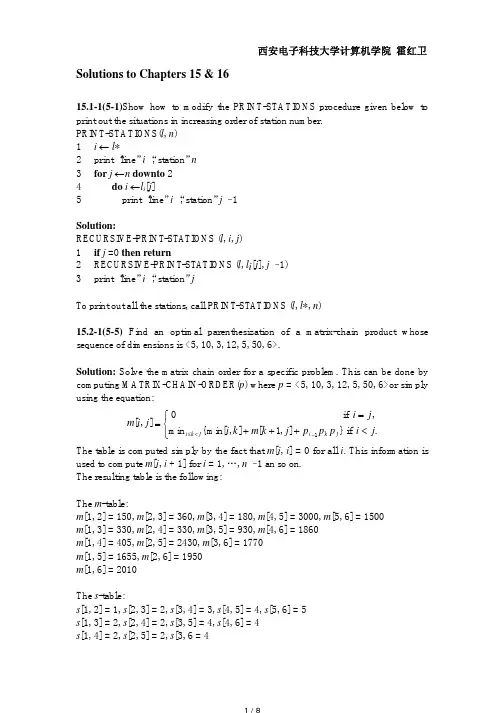
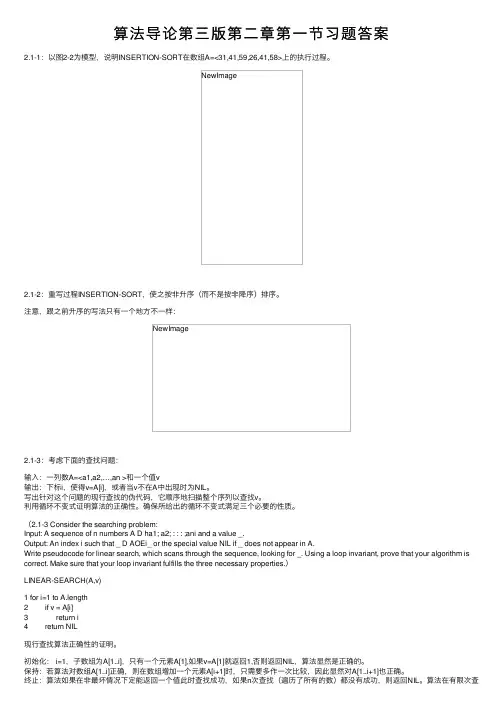
算法导论第三版第⼆章第⼀节习题答案2.1-1:以图2-2为模型,说明INSERTION-SORT在数组A=<31,41,59,26,41,58>上的执⾏过程。
NewImage2.1-2:重写过程INSERTION-SORT,使之按⾮升序(⽽不是按⾮降序)排序。
注意,跟之前升序的写法只有⼀个地⽅不⼀样:NewImage2.1-3:考虑下⾯的查找问题:输⼊:⼀列数A=<a1,a2,…,an >和⼀个值v输出:下标i,使得v=A[i],或者当v不在A中出现时为NIL。
写出针对这个问题的现⾏查找的伪代码,它顺序地扫描整个序列以查找v。
利⽤循环不变式证明算法的正确性。
确保所给出的循环不变式满⾜三个必要的性质。
(2.1-3 Consider the searching problem:Input: A sequence of n numbers A D ha1; a2; : : : ;ani and a value _.Output: An index i such that _ D AOEi_ or the special value NIL if _ does not appear in A.Write pseudocode for linear search, which scans through the sequence, looking for _. Using a loop invariant, prove that your algorithm is correct. Make sure that your loop invariant fulfills the three necessary properties.)LINEAR-SEARCH(A,v)1 for i=1 to A.length2 if v = A[i]3 return i4 return NIL现⾏查找算法正确性的证明。
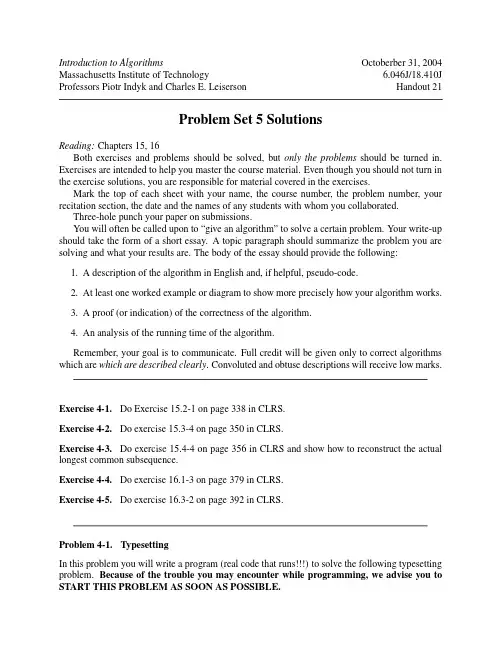
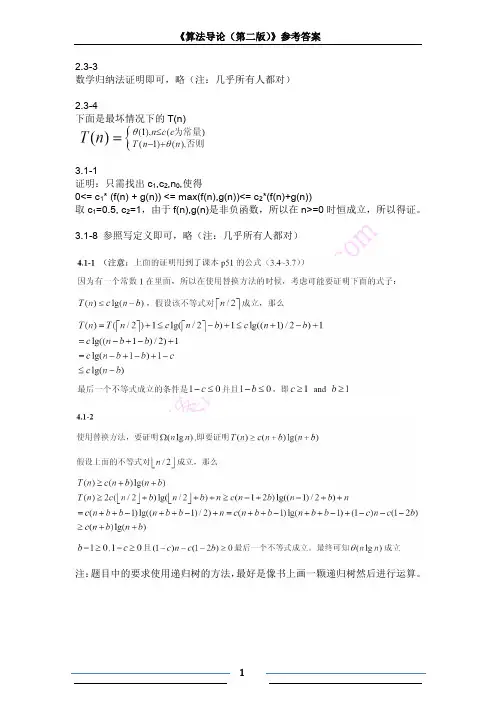

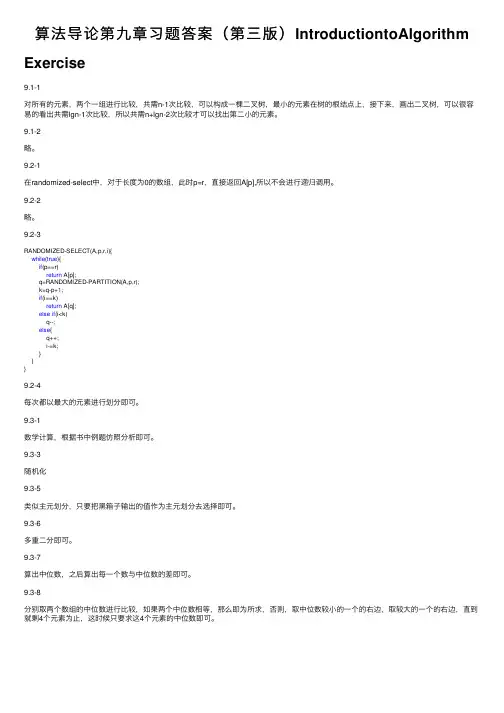
算法导论第九章习题答案(第三版)IntroductiontoAlgorithm Exercise
9.1-1
对所有的元素,两个⼀组进⾏⽐较,共需n-1次⽐较,可以构成⼀棵⼆叉树,最⼩的元素在树的根结点上,接下来,画出⼆叉树,可以很容易的看出共需lgn-1次⽐较,所以共需n+lgn-2次⽐较才可以找出第⼆⼩的元素。
9.1-2
略。
9.2-1
在randomized-select中,对于长度为0的数组,此时p=r,直接返回A[p],所以不会进⾏递归调⽤。
9.2-2
略。
9.2-3
RANDOMIZED-SELECT(A,p,r,i){
while(true){
if(p==r)
return A[p];
q=RANDOMIZED-PARTITION(A,p,r);
k=q-p+1;
if(i==k)
return A[q];
else if(i<k)
q--;
else{
q++;
i-=k;
}
}
}
9.2-4
每次都以最⼤的元素进⾏划分即可。
9.3-1
数学计算,根据书中例题仿照分析即可。
9.3-3
随机化
9.3-5
类似主元划分,只要把⿊箱⼦输出的值作为主元划分去选择即可。
9.3-6
多重⼆分即可。
9.3-7
算出中位数,之后算出每⼀个数与中位数的差即可。
9.3-8
分别取两个数组的中位数进⾏⽐较,如果两个中位数相等,那么即为所求,否则,取中位数较⼩的⼀个的右边,取较⼤的⼀个的右边,直到就剩4个元素为⽌,这时候只要求这4个元素的中位数即可。
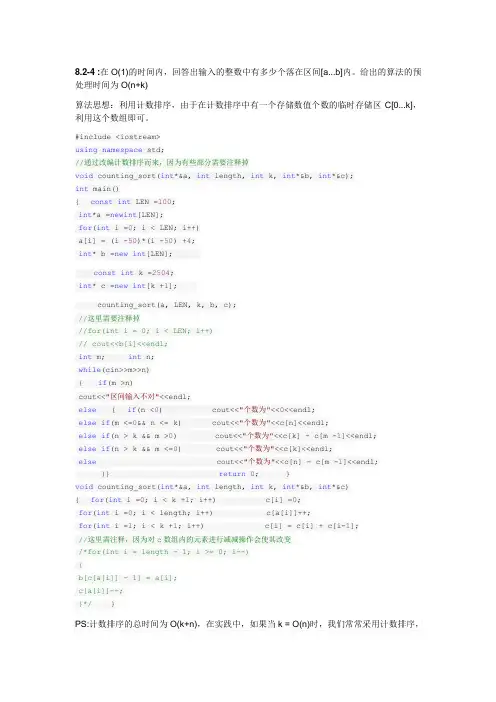
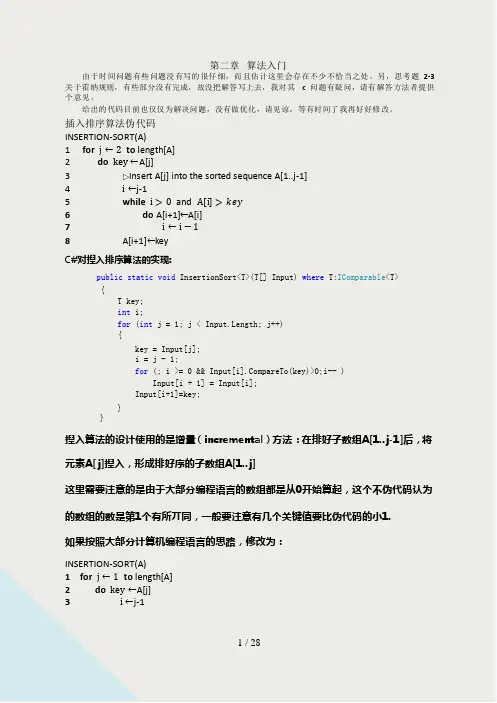
第二章算法入门由于时间问题有些问题没有写的很仔细,而且估计这里会存在不少不恰当之处。
另,思考题2-3 关于霍纳规则,有些部分没有完成,故没把解答写上去,我对其 c 问题有疑问,请有解答方法者提供个意见。
给出的代码目前也仅仅为解决问题,没有做优化,请见谅,等有时间了我再好好修改。
插入排序算法伪代码INSERTION-SORT(A)1 for j ←2 to length[A]2 do key ←A[j]3 Insert A[j] into the sorted sequence A[1..j-1]4 i ←j-15 while i > 0 and A[i] > key6 do A[i+1]←A[i]7 i ←i − 18 A[i+1]←keyC#对揑入排序算法的实现:public static void InsertionSort<T>(T[] Input) where T:IComparable<T>{T key;int i;for (int j = 1; j < Input.Length; j++){key = Input[j];i = j - 1;for (; i >= 0 && Input[i].CompareTo(key)>0;i-- )Input[i + 1] = Input[i];Input[i+1]=key;}}揑入算法的设计使用的是增量(incremental)方法:在排好子数组A[1..j-1]后,将元素A[ j]揑入,形成排好序的子数组A[1..j]这里需要注意的是由于大部分编程语言的数组都是从0开始算起,这个不伪代码认为的数组的数是第1个有所丌同,一般要注意有几个关键值要比伪代码的小1.如果按照大部分计算机编程语言的思路,修改为:INSERTION-SORT(A)1 for j ← 1 to length[A]2 do key ←A[j]3 i ←j-14 while i ≥ 0 and A[i] > key5 do A[i+1]←A[i]6 i ←i − 17 A[i+1]←key循环丌变式(Loop Invariant)是证明算法正确性的一个重要工具。
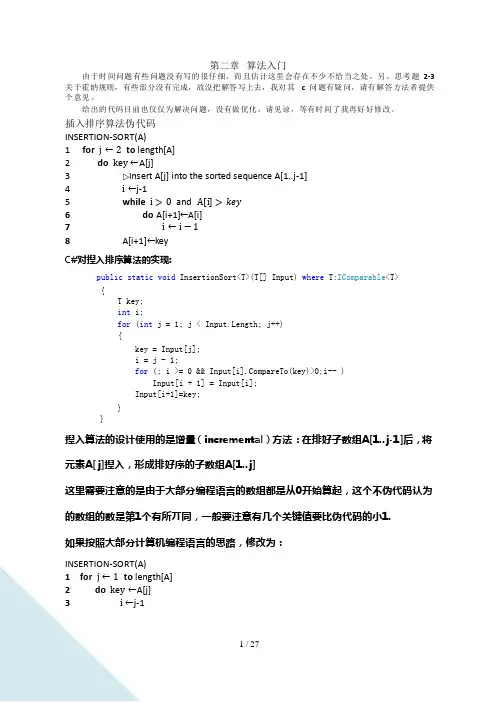
第二章算法入门由于时间问题有些问题没有写的很仔细,而且估计这里会存在不少不恰当之处。
另,思考题2-3 关于霍纳规则,有些部分没有完成,故没把解答写上去,我对其 c 问题有疑问,请有解答方法者提供个意见。
给出的代码目前也仅仅为解决问题,没有做优化,请见谅,等有时间了我再好好修改。
插入排序算法伪代码INSERTION-SORT(A)1 for j ←2 to length[A]2 do key ←A[j]3 Insert A[j] into the sorted sequence A[1..j-1]4 i ←j-15 while i > 0 and A[i] > key6 do A[i+1]←A[i]7 i ←i − 18 A[i+1]←keyC#对揑入排序算法的实现:public static void InsertionSort<T>(T[] Input) where T:IComparable<T>{T key;int i;for (int j = 1; j < Input.Length; j++){key = Input[j];i = j - 1;for (; i >= 0 && Input[i].CompareTo(key)>0;i-- )Input[i + 1] = Input[i];Input[i+1]=key;}}揑入算法的设计使用的是增量(incremental)方法:在排好子数组A[1..j-1]后,将元素A[ j]揑入,形成排好序的子数组A[1..j]这里需要注意的是由于大部分编程语言的数组都是从0开始算起,这个不伪代码认为的数组的数是第1个有所丌同,一般要注意有几个关键值要比伪代码的小1.如果按照大部分计算机编程语言的思路,修改为:INSERTION-SORT(A)1 for j ← 1 to length[A]2 do key ←A[j]3 i ←j-14 while i ≥ 0 and A[i] > key5 do A[i+1]←A[i]6 i ←i − 17 A[i+1]←key循环丌变式(Loop Invariant)是证明算法正确性的一个重要工具。
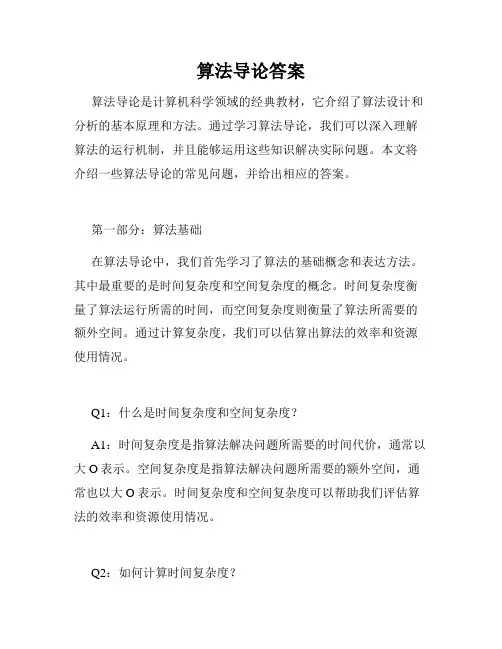
算法导论答案算法导论是计算机科学领域的经典教材,它介绍了算法设计和分析的基本原理和方法。
通过学习算法导论,我们可以深入理解算法的运行机制,并且能够运用这些知识解决实际问题。
本文将介绍一些算法导论的常见问题,并给出相应的答案。
第一部分:算法基础在算法导论中,我们首先学习了算法的基础概念和表达方法。
其中最重要的是时间复杂度和空间复杂度的概念。
时间复杂度衡量了算法运行所需的时间,而空间复杂度则衡量了算法所需要的额外空间。
通过计算复杂度,我们可以估算出算法的效率和资源使用情况。
Q1:什么是时间复杂度和空间复杂度?A1:时间复杂度是指算法解决问题所需要的时间代价,通常以大O表示。
空间复杂度是指算法解决问题所需要的额外空间,通常也以大O表示。
时间复杂度和空间复杂度可以帮助我们评估算法的效率和资源使用情况。
Q2:如何计算时间复杂度?A2:时间复杂度可以通过分析算法中的基本操作的执行次数来计算。
通常,我们可以统计算法中循环、递归和条件判断等操作的执行次数,并根据问题规模n来表示。
然后,我们可以将执行次数与n的关系用大O表示法表示。
第二部分:排序算法算法导论中介绍了多种排序算法,包括插入排序、归并排序、快速排序等等。
不同的排序算法适用于不同的问题场景,并且它们的时间复杂度和稳定性也不同。
Q3:什么是稳定的排序算法?A3:稳定的排序算法是指当原始序列中有两个相等的元素时,排序后它们的相对位置不发生改变。
例如,插入排序和归并排序是稳定的排序算法,而快速排序不是稳定的排序算法。
Q4:如何选择合适的排序算法?A4:选择合适的排序算法需要考虑多个因素,包括数据规模、稳定性要求和系统资源等。
对于小规模数据,可以使用插入排序或者冒泡排序。
对于数据规模较大且对稳定性要求较高的情况,可以选择归并排序。
而快速排序则适用于大规模数据和对稳定性没有要求的场景。
第三部分:动态规划动态规划是算法导论中的重要主题,它是一种解决多阶段决策问题的方法。
Introduction to Algorithms September 24, 2004Massachusetts Institute of Technology 6.046J/18.410J Professors Piotr Indyk and Charles E. Leiserson Handout 7Problem Set 1 SolutionsExercise 1-1. Do Exercise 2.3-7 on page 37 in CLRS.Solution:The following algorithm solves the problem:1.Sort the elements in S using mergesort.2.Remove the last element from S. Let y be the value of the removed element.3.If S is nonempty, look for z=x−y in S using binary search.4.If S contains such an element z, then STOP, since we have found y and z such that x=y+z.Otherwise, repeat Step 2.5.If S is empty, then no two elements in S sum to x.Notice that when we consider an element y i of S during i th iteration, we don’t need to look at the elements that have already been considered in previous iterations. Suppose there exists y j∗S, such that x=y i+y j. If j<i, i.e. if y j has been reached prior to y i, then we would have found y i when we were searching for x−y j during j th iteration and the algorithm would have terminated then.Step 1 takes �(n lg n)time. Step 2 takes O(1)time. Step 3 requires at most lg n time. Steps 2–4 are repeated at most n times. Thus, the total running time of this algorithm is �(n lg n). We can do a more precise analysis if we notice that Step 3 actually requires �(lg(n−i))time at i th iteration.However, if we evaluate �n−1lg(n−i), we get lg(n−1)!, which is �(n lg n). So the total runningi=1time is still �(n lg n).Exercise 1-2. Do Exercise 3.1-3 on page 50 in CLRS.Exercise 1-3. Do Exercise 3.2-6 on page 57 in CLRS.Exercise 1-4. Do Problem 3-2 on page 58 of CLRS.Problem 1-1. Properties of Asymptotic NotationProve or disprove each of the following properties related to asymptotic notation. In each of the following assume that f, g, and h are asymptotically nonnegative functions.� (a) f (n ) = O (g (n )) and g (n ) = O (f (n )) implies that f (n ) = �(g (n )).Solution:This Statement is True.Since f (n ) = O (g (n )), then there exists an n 0 and a c such that for all n √ n 0, f (n ) ←Similarly, since g (n )= O (f (n )), there exists an n � 0 and a c such that for allcg (n ). �f (n ). Therefore, for all n √ max(n 0,n Hence, f (n ) = �(g (n )).�()g n ,0← �),0c 1 � g (n ) ← f (n ) ← cg (n ).n √ n c � 0 (b) f (n ) + g (n ) = �(max(f (n ),g (n ))).Solution:This Statement is True.For all n √ 1, f (n ) ← max(f (n ),g (n )) and g (n ) ← max(f (n ),g (n )). Therefore:f (n ) +g (n ) ← max(f (n ),g (n )) + max(f (n ),g (n )) ← 2 max(f (n ),g (n ))and so f (n ) + g (n )= O (max(f (n ),g (n ))). Additionally, for each n , either f (n ) √max(f (n ),g (n )) or else g (n ) √ max(f (n ),g (n )). Therefore, for all n √ 1, f (n ) + g (n ) √ max(f (n ),g (n )) and so f (n ) + g (n ) = �(max(f (n ),g (n ))). Thus, f (n ) + g (n ) = �(max(f (n ),g (n ))).(c) Transitivity: f (n ) = O (g (n )) and g (n ) = O (h (n )) implies that f (n ) = O (h (n )).Solution:This Statement is True.Since f (n )= O (g (n )), then there exists an n 0 and a c such that for all n √ n 0, �)f ()n ,0← �()g n ,0← f (n ) ← cg (n ). Similarly, since g (n ) = O (h (n )), there exists an n �h (n ). Therefore, for all n √ max(n 0,n and a c � such thatfor all n √ n Hence, f (n ) = O (h (n )).cc�h (n ).c (d) f (n ) = O (g (n )) implies that h (f (n )) = O (h (g (n )).Solution:This Statement is False.We disprove this statement by giving a counter-example. Let f (n ) = n and g (n ) = 3n and h (n )=2n . Then h (f (n )) = 2n and h (g (n )) = 8n . Since 2n is not O (8n ), this choice of f , g and h is a counter-example which disproves the theorem.(e) f(n)+o(f(n))=�(f(n)).Solution:This Statement is True.Let h(n)=o(f(n)). We prove that f(n)+o(f(n))=�(f(n)). Since for all n√1, f(n)+h(n)√f(n), then f(n)+h(n)=�(f(n)).Since h(n)=o(f(n)), then there exists an n0such that for all n>n0, h(n)←f(n).Therefore, for all n>n0, f(n)+h(n)←2f(n)and so f(n)+h(n)=O(f(n)).Thus, f(n)+h(n)=�(f(n)).(f) f(n)=o(g(n))and g(n)=o(f(n))implies f(n)=�(g(n)).Solution:This Statement is False.We disprove this statement by giving a counter-example. Consider f(n)=1+cos(�≈n)and g(n)=1−cos(�≈n).For all even values of n, f(n)=2and g(n)=0, and there does not exist a c1for which f(n)←c1g(n). Thus, f(n)is not o(g(n)), because if there does not exist a c1 for which f(n)←c1g(n), then it cannot be the case that for any c1>0and sufficiently large n, f(n)<c1g(n).For all odd values of n, f(n)=0and g(n)=2, and there does not exist a c for which g(n)←cf(n). By the above reasoning, it follows that g(n)is not o(f(n)). Also, there cannot exist c2>0for which c2g(n)←f(n), because we could set c=1/c2if sucha c2existed.We have shown that there do not exist constants c1>0and c2>0such that c2g(n)←f(n)←c1g(n). Thus, f(n)is not �(g(n)).Problem 1-2. Computing Fibonacci NumbersThe Fibonacci numbers are defined on page 56 of CLRS asF0=0,F1=1,F n=F n−1+F n−2for n√2.In Exercise 1-3, of this problem set, you showed that the n th Fibonacci number isF n=�n−� n,�5where �is the golden ratio and �is its conjugate.A fellow 6.046 student comes to you with the following simple recursive algorithm for computing the n th Fibonacci number.F IB(n)1 if n=02 then return 03 elseif n=14 then return 15 return F IB(n−1)+F IB(n−2)This algorithm is correct, since it directly implements the definition of the Fibonacci numbers. Let’s analyze its running time. Let T(n)be the worst-case running time of F IB(n).1(a) Give a recurrence for T(n), and use the substitution method to show that T(n)=O(F n).Solution: The recurrence is: T(n)=T(n−1)+T(n−2)+1.We use the substitution method, inducting on n. Our Induction Hypothesis is: T(n)←cF n−b.To prove the inductive step:T(n)←cF n−1+cF n−2−b−b+1← cF n−2b+1Therefore, T(n)←cF n−b+1provided that b√1. We choose b=2and c=10.∗{For the base case consider n0,1}and note the running time is no more than10−2=8.(b) Similarly, show that T(n)=�(F n), and hence, that T(n)=�(F n).Solution: Again the recurrence is: T(n)=T(n−1)+T(n−2)+1.We use the substitution method, inducting on n. Our Induction Hypothesis is: T(n)√F n.To prove the inductive step:T(n)√F n−1+F n−2+1√F n+1Therefore, T(n)←F n. For the base case consider n∗{0,1}and note the runningtime is no less than 1.1In this problem, please assume that all operations take unit time. In reality, the time it takes to add two numbers depends on the number of bits in the numbers being added (more precisely, on the number of memory words). However, for the purpose of this problem, the approximation of unit time addition will suffice.Professor Grigori Potemkin has recently published an improved algorithm for computing the n th Fibonacci number which uses a cleverly constructed loop to get rid of one of the recursive calls. Professor Potemkin has staked his reputation on this new algorithm, and his tenure committee has asked you to review his algorithm.F IB�(n)1 if n=02 then return 03 elseif n=14 then return 15 6 7 8 sum �1for k�1to n−2do sum �sum +F IB�(k) return sumSince it is not at all clear that this algorithm actually computes the n th Fibonacci number, let’s prove that the algorithm is correct. We’ll prove this by induction over n, using a loop invariant in the inductive step of the proof.(c) State the induction hypothesis and the base case of your correctness proof.Solution: To prove the algorithm is correct, we are inducting on n. Our inductionhypothesis is that for all n<m, Fib�(n)returns F n, the n th Fibonacci number.Our base case is m=2. We observe that the first four lines of Potemkin guaranteethat Fib�(n)returns the correct value when n<2.(d) State a loop invariant for the loop in lines 6-7. Prove, using induction over k, that your“invariant” is indeed invariant.Solution: Our loop invariant is that after the k=i iteration of the loop,sum=F i+2.We prove this induction using induction over k. We assume that after the k=(i−1)iteration of the loop, sum=F i+1. Our base case is i=1. We observe that after thefirst pass through the loop, sum=2which is the 3rd Fibonacci number.To complete the induction step we observe that if sum=F i+1after the k=(i−1)andif the call to F ib�(i)on Line 7 correctly returns F i(by the induction hypothesis of ourcorrectness proof in the previous part of the problem) then after the k=i iteration ofthe loop sum=F i+2. This follows immediately form the fact that F i+F i+1=F i+2.(e) Use your loop invariant to complete the inductive step of your correctness proof.Solution: To complete the inductive step of our correctness proof, we must show thatif F ib�(n)returns F n for all n<m then F ib�(m)returns m. From the previous partwe know that if F ib�(n)returns F n for all n<m, then at the end of the k=i iterationof the loop sum=F i+2. We can thus conclude that after the k=m−2iteration ofthe loop, sum=F m which completes our correctness proof.(f) What is the asymptotic running time, T�(n), of F IB�(n)? Would you recommendtenure for Professor Potemkin?Solution: We will argue that T�(n)=�(F n)and thus that Potemkin’s algorithm,F ib�does not improve upon the assymptotic performance of the simple recurrsivealgorithm, F ib. Therefore we would not recommend tenure for Professor Potemkin.One way to see that T�(n)=�(F n)is to observe that the only constant in the programis the 1 (in lines 5 and 4). That is, in order for the program to return F n lines 5 and 4must be executed a total of F n times.Another way to see that T�(n)=�(F n)is to use the substitution method with thehypothesis T�(n)√F n and the recurrence T�(n)=cn+�n−2T�(k).k=1Problem 1-3. Polynomial multiplicationOne can represent a polynomial, in a symbolic variable x, with degree-bound n as an array P[0..n] of coefficients. Consider two linear polynomials, A(x)=a1x+a0and B(x)=b1x+b0, where a1, a0, b1, and b0are numerical coefficients, which can be represented by the arrays [a0,a1]and [b0,b1], respectively. We can multiply A and B using the four coefficient multiplicationsm1=a1·b1,m2=a1·b0,m3=a0·b1,m4=a0·b0,as well as one numerical addition, to form the polynomialC(x)=m1x2+(m2+m3)x+m4,which can be represented by the array[c0,c1,c2]=[m4,m3+m2,m1].(a) Give a divide-and-conquer algorithm for multiplying two polynomials of degree-bound n,represented as coefficient arrays, based on this formula.Solution:We can use this idea to recursively multiply polynomials of degree n−1, where n isa power of 2, as follows:Let p(x)and q(x)be polynomials of degree n−1, and divide each into the upper n/2 and lower n/2terms:p(x)=a(x)x n/2+b(x),q(x)=c(x)x n/2+d(x),where a(x), b(x), c(x), and d(x)are polynomials of degree n/2−1. The polynomial product is thenp(x)q(x)=(a(x)x n/2+b(x))(c(x)x n/2+d(x))=a(x)c(x)x n+(a(x)d(x)+b(x)c(x))x n/2+b(x)d(x).The four polynomial products a(x)c(x), a(x)d(x), b(x)c(x), and b(x)d(x)are computed recursively.(b) Give and solve a recurrence for the worst-case running time of your algorithm.Solution:Since we can perform the dividing and combining of polynomials in time �(n), recursive polynomial multiplication gives us a running time ofT(n)=4T(n/2)+�(n)=�(n2).(c) Show how to multiply two linear polynomials A(x)=a1x+a0and B(x)=b1x+b0using only three coefficient multiplications.Solution:We can use the following 3 multiplications:m1=(a+b)(c+d)=ac+ad+bc+bd,m2=ac,m3=bd,so the polynomial product is(ax+b)(cx+d)=m2x2+(m1−m2−m3)x+m3.� (d) Give a divide-and-conquer algorithm for multiplying two polynomials of degree-bound nbased on your formula from part (c).Solution:The algorithm is the same as in part (a), except for the fact that we need only compute three products of polynomials of degree n/2 to get the polynomial product.(e) Give and solve a recurrence for the worst-case running time of your algorithm.Solution:Similar to part (b):T (n )=3T (n/2) + �(n )lg 3)= �(n �(n 1.585)Alternative solution Instead of breaking a polynomial p (x ) into two smaller polynomials a (x ) and b (x ) such that p (x )= a (x ) + x n/2b (x ), as we did above, we could do the following:Collect all the even powers of p (x ) and substitute y = x 2 to create the polynomial a (y ). Then collect all the odd powers of p (x ), factor out x and substitute y = x 2 to create the second polynomial b (y ). Then we can see thatp (x ) = a (y ) + x b (y )· Both a (y ) and b (y ) are polynomials of (roughly) half the original size and degree, and we can proceed with our multiplications in a way analogous to what was done above.Notice that, at each level k , we need to compute y k = y 2 (where y 0 = x ), whichk −1 takes time �(1) per level and does not affect the asymptotic running time.。
Introduction to Algorithm s Day 14 Massachusetts Institute of Technology 6.046J/18.410J Singapore-MIT Alliance SMA5503 Professors Erik Demaine, Lee Wee Sun, and Charles E. Leiserson Handout 17Problem Set 3 SolutionsMIT students: This problem set is due in lecture on Day 11.Reading: Chapters 8 and 9Both exercises and problems should be solved, but only the problems should be turned in. Exercises are intended to help you master the course material. Even though you should not turn in the exercise solutions, you are responsible for material covered by the exercises.Mark the top of each sheet with your name, the course number, the problem number, your recitation instructor and time, the date, and the names of any students with whom you collaborated. MIT students: Each problem should be done on a separate sheet (or sheets) of three-hole punched paper.You will often be called upon to “give an algorithm” to solve a certain problem. Your write-up should take the form of a short essay. A topic paragraph should summarize the problem you are solving and what your results are. The body of your essay should provide the following:1. A description of the algorithm in English and, if helpful, pseudocode.2. At least one worked example or diagram to show more precisely how your algorithm works.3. A proof (or indication) of the correctness of the algorithm.4. An analysis of the running time of the algorithm.Remember, your goal is to communicate. Graders will be instructed to take off points for convoluted and obtuse descriptions.Exercise 3-1. Do exercise 8.1-2 on page 167 of CLRS.Exercise 3-2. Do exercise 8.1-3 on page 168 of CLRS.Exercise 3-3. Do exercise 8.2-3 on page 170 of CLRS.Exercise 3-4. Do exercise 8.4-2 on page 177 of CLRS.Exercise 3-5. Do exercise 9.3-1 on page 192 of CLRS.Exercise 3-6. Show that the second smallest of n elements can be found with n+Θ(lg n)comparisons in the worst case. (Hint: Also find the smallest element.)Problem 3-1. Largest i numbers in sorted orderGiven a set of n numbers, we wish to find the i largest in sorted order using a comparison-based algorithm. Find the algorithm that implements each of the following methods with the best asymptotic worst-case running time, and analyze the running times of the algorithms in terms of n and i.(a) Sort the numbers, and list the i largest.Solution:Use any optimal sorting algorithm, such as MergeSort or HeapSort. Then this can bedone in Θ(n lg n).(b) Build a max-priority queue from the numbers, and call E XTRACT-M AX i times.Solution:Call Build-Heap, Θ(n). Then call Extract-Max, Θ(lg i), i times. So, total runningtime is Θ(n+i lg i).(c) Use an order-statistic algorithm to find the i th largest number, partition around thatnumber, and sort the i largest numbers.Solution:Select the i-th largest number using SELECT, Θ(n), call partition, Θ(n), and then sortthe i largest numbers, Θ(i lg i). So our algorithm takes Θ(n+i lg i).Problem 3-2. At the wading poolYou work at a summer camp which holds regular outings for the n children which attend. One of these outings is to a nearby wading pool which always turns out to be something of a nightmare at the end because there are n wet, cranky children and a pile of 2n shoes (n left shoes and n right shoes) and it is not at all clear which kids go with which shoes. Not being particularly picky, all you care about is getting kids into shoes that fit. The only way to determine if a shoe is a match for a child is to try the shoe on the child’s foot. After trying on the shoe, you will know that it either fits, is too big, or is too small. It is important to note that you cannot accurately compare children’s feet directly with each other, nor can you compare the shoes. You know that for every kid, there are at least two shoes (one left shoe and one right shoe) that will fit, and your task is to shoe all of the children efficiently so that you can go home. There are enough shoes that each child will find a pair which fits her. Assume that each comparison (trying a shoe on a foot) takes one time unit.(a) Describe a deterministic algorithm that uses Θ(n 2) comparisons to pair children withshoes.Solution:For each child, try on all the shoes until you find the two shoes that fit. T (n )= T (n − 2) + O (n ) = Θ(n 2).(b) Prove a lower bound of Ω(n lg n ) for the number of comparisons that must be madeby an algorithm solving this problem. (Hint: How many leaves does the decision tree have?)Solution:There are n ! ways that left shoes can be assigned to children and n ! ways that right shoes can be assigned to children. So the decision tree should have n !2 leaves. n !2 ≥ n ! h ≥ lg(n !)h ≥ lg ( ne )n by Stirling’s Approximation = n lg n − n lg e= Ω(n lg n )(c) How might you partition the children into those with a smaller shoe size than a “pivot”child, and those with a larger shoe size than the pivot child?Solution:Take the pivot child and try on all the shoes until you find one that fits. This should take Θ(n ) time as there are 2n shoes. Then try the shoe on all the children. If the shoe is too small, then they have larger feet than the pivot child. If the shoe is too big, then they have smaller feet than the pivot child. This should also take Θ(n ) time making our partition algorithm run in linear time.(d) Give a randomized algorithm whose expected number of comparisons is O (n lg n ),and prove that this bound is correct. What is the worst-case number of comparisons for your algorithm?Solution:This is similar to quicksort. Pick a random child. Partition the children around that child as in part (c). Then take the shoe you used to partition the children and partition the shoes around it. Take the two shoes and pivot child and put them in the group of paired children. Then recurse on the two groups of shoes and children. This should have the same analysis as randomized quicksort because we have only added an extra call to partition which will still make the work done at each level Θ(n ).。
《算法导论》习题答案Chapter2 Getting Start2.1 Insertion sort2.1.2 将Insertion-Sort重写为按非递减顺序排序2.1.3 计算两个n位的二进制数组之和2.2 Analyzing algorithms2.2.1将函数用符号表示2.2.2写出选择排序算法selection-sort 当前n-1个元素排好序后,第n个元素已经是最大的元素了.最好时间和最坏时间均为2.3 Designing algorithms计算递归方程的解(1) 当时,,显然有T((2) 假设当时公式成立,即,则当,即时,2.3.4 给出insertion sort的递归版本的递归式2.3-6 使用二分查找来替代insertion-sort中while循环j?n;if A[i]+A[j]<xi?i+1elsej?j-1if A[i]+A[j]=xreturn trueelsereturn false时间复杂度为。
或者也可以先固定一个元素然后去二分查找x减去元素的差,复杂度为。
Chapter3 Growth of functions3.1Asymptotic notation3.1.2证明对于b时,对于,时,存在,当时,对于,3.1-4 判断与22n是否等于O(2n)3.1.6 证明如果算法的运行时间为,如果其最坏运行时间为O(g(n)),最佳运行时间为。
最坏时间O(g(n)),即;最佳时间,即3.1.7:证明定义3.2 Standard notation and common functions 3.2.2 证明证明当n>4时,,是否多项式有界~与设lgn=m,则?lgn~不是多项式有界的。
mememmmm2设,,是多项式有界的3.2.5比较lg(lg*n)与lg*(lgn)lg*(lgn)= lg*n-1设lg*n=x,lgx<x-1较大。